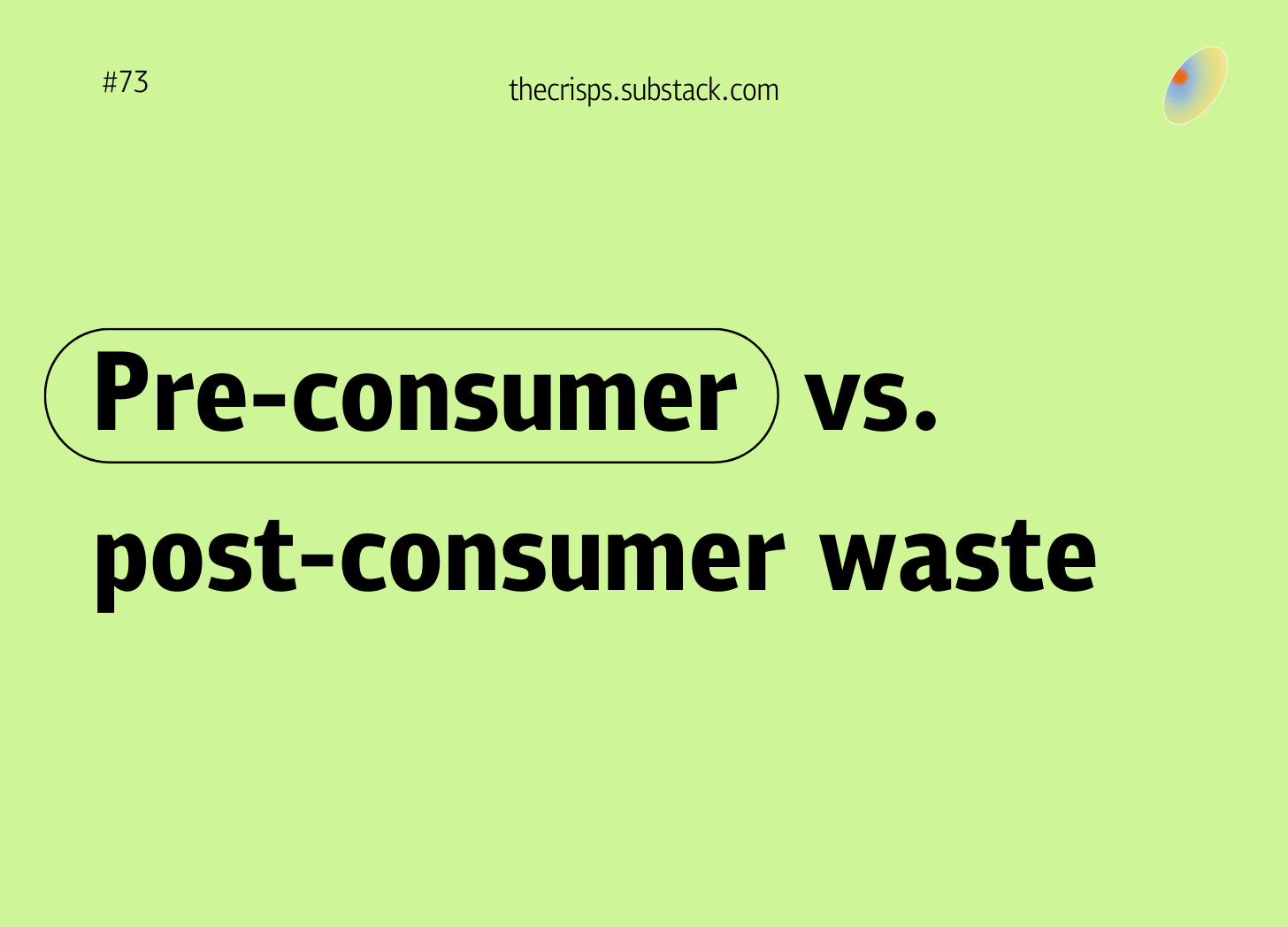Why zero waste is more than using deadstock material
From waste streams to wrong zero-waste claims and how to do it right
Welcome back to another issue of The Crisps–your newsletter on anti-greenwashing and honest fashion communication. You can support us by subscribing, liking, and sharing our posts.
It’s one of those phrases that sounds like a really good thing. In fashion, it’s been embraced with particular enthusiasm. “Zero-waste collections” and “waste-free processes” seem to solve a huge issue of the industry. But the deeper you dig, the more you realize that brands and the industry oftentimes can’t hold up to these promises.
In this issue, we look at what zero waste means, break down the different types of waste that occur before and after production, and dive into why using deadstock material doesn’t equal zero waste.
We don’t however go into detail on waste management from a circularity point of view – but will link to our previous issues covering circularity and will dedicate a separate issue to this topic again soon!
But before we dive in, a quick note on the spelling:
The noun zero waste is written without a hyphen.
The adjective zero-waste (as in zero-waste design) is written with a hyphen.
All the best,
Tanita & Lavinia
What does “zero waste” really mean?
It’s easy for brands to highlight their deadstock use while quietly continuing to mass-produce endless collections, or to run recycling campaigns while still churning out hyper-trendy and short-lived styles destined for landfill.
Before we look at the dos & don’ts, let’s cover some basic ground.
The Zero Waste International Alliance coined the term “zero waste” in 2004. Its last update was published in 20181:
“Zero Waste: The conservation of all resources by means of responsible production, consumption, reuse, and recovery of products, packaging, and materials without burning and with no discharges to land, water, or air that threaten the environment or human health.”
Translated to fashion, zero waste means rethinking design, production, and business models to avoid the creation of waste and managing waste properly with as little environmental and social harmful impacts as possible. This includes:
🔹 Zero-waste pattern cutting where garments are designed to use every bit of fabric and avoid off-cuts.
🔹 Design for disassembly where garments are built to be easily taken apart and reused or recycled at end-of-life.
🔹 Timeless design which avoids pieces going out of trend within weeks or months and becoming waste quickly.
🔹 Material choices where mono-materials are preferred over blends that are hard to recycle (note: textile-to-textile recycling for mono-materials is also not scaled yet!).
🔹 Chemical management where chemicals are chosen and handled that don’t leave harmful traces in the environment and our health.
🔹 Manufacturing that anticipates order volumes well or uses on demand (made-to-order models) rather than overproducing.
🔹 Circularity (but we will go into this in a separate issue – because it’s a huge topic with so many things to consider!)
To fully understand how to communicate about zero waste, we first have to understand where waste is generated in fashion supply webs. And how and where it can be avoided. Let’s break down where waste actually occurs.
Pre-consumer waste
When we talk about waste in fashion, most people immediately think of what happens after a garment is worn – donations, recycling bins or thrift shops. But in reality, a significant amount of waste occurs long before a product ever reaches the customer. Pre-consumer (or some equal it to post-industrial) waste includes excess fabric ordered, sample garments created for approvals, rejected dye lots, offcuts, damaged goods, faulty runs, surplus trims, unsold stock from overproduction and warehouse leftovers. It's the kind of waste that often stays invisible. But it can account for considerable volumes of discarded materials.
Even with efforts to reuse scraps or donate materials, these streams often get downcycled or dumped because they're deemed too low in value to salvage. It’s a major gap in the industry’s zero-waste storytelling – brands rarely talk about what happens during production, even though this is where a huge portion of the problem begins.
Post-consumer waste
Finally, there's post-consumer waste. Or the waste we actually see. These are the garments we throw away, donate, resell or return. It's the part most brands love to focus on, especially when promoting circularity through resale platforms, recycling programs, or take-back boxes. But at the moment, a huge part of the collected clothing still ends up in landfills or is incinerated.
So when communicating about zero waste principles, be super clear which waste you’re talking about! Are you talking about the waste at the design and production stage? Or at the product’s end-of-life (cradle to gate)?
Rescuing abandoned rolls of fabric from dusty warehouses and turning them into clothes? Sounds amazing! But (surprise, surprise), the truth is a little less shiny.
Deadstock fabric refers to surplus fabric that was produced but never used. Sometimes these materials come from overestimations by manufacturers or from cancelled orders from brands. Deadstock can also result from discontinued styles or even small defects like slight color mismatches or minor weave irregularities. Instead of sending these materials straight to landfill or incineration, some brands scoop them up and repurpose them into limited collections.
To be fair, there are real upsides to working with deadstock material, as it reduces the immediate need for new resource-intensive textile production. It also offers a way to create unique, small-batch designs.
But here’s where the story gets complicated: Deadstock isn’t always the solution it’s sold as. Behind the scenes, some manufacturers have figured out there’s good money in “leftovers”. In some cases, overproduction is now a strategy. Produce more fabric than needed, market the excess as deadstock and voilà: waste becomes an asset.
The biggest trap, though, is the narrative itself. Some brands slap "deadstock" onto a capsule collection to project a resource-sensitive image, while the bulk of their business continues unchanged. This is classic greenwashing: highlighting isolated good deeds to mask a fundamentally unsustainable model. To truly harness the potential of deadstock, brands need to implement real transparency and clearly communicate where the materials come from.
BECOME A SPONSOR
If you want to support us, you can! One-off contributions are always welcome. We’re also exploring sponsorship opportunities that align with our principles. If you would like to support our work, please get in touch.
To grasp the topic better, let’s look at some examples:
🔸 “Zero-waste collection”
If the term is used to describe a collection where only one stage of the process, like the pattern cutting, was optimized, it’s misleading. Imagine a polyester collection where less waste was generated at the production stage but the items themselves end up as trash because in practice, they won’t be recycled and only break down after hundreds of years while leaching harmful substances. Not so much zero waste.
🔸“We use deadstock fabrics, so our brand is zero waste.”
Using deadstock doesn’t automatically make the entire brand implement zero waste. It addresses surplus, but doesn’t holistically prevent waste creation at every stage. Calling your entire brand zero waste has to include more than one stage.
🔸“Avoiding waste”
If a brand says it "avoids waste" but doesn't detail methods, it’s too vague. Specify how you do it. Made-to-order? Special cutting techniques? And specify in which stage you avoid it – in the production phase, or is your product compostable and therefore avoiding waste at the end of the lifecycle?
🔸 “Zero-waste biker shorts from recycled polyester”
A product description calling a recycled polyester item zero-waste because it’s made from plastic bottles does not equal zero waste – especially not if the garment isn’t recyclable again and sheds additional, polluting microplastics.
Here’s how to do it better:
Define the method:
🔹 “This piece was designed using zero-waste pattern cutting techniques, meaning the layout was optimized to use 95 % of the fabric with minimal offcuts.”
🔹 “We design with end-of-life in mind: this piece can be fully composted at home and leaves no waste or harmful impacts after you’re done wearing it.” (Although this is very rarely accomplished from a technical viewpoint.)
Be clear on the stage you refer to:
🔹 “Our zero-waste design process integrates pattern cutting and design from the start to eliminate production scraps.”
🔹 “Our zero-waste approach focuses on minimizing cutting waste in the sampling and production stages.”
🔹 “Instead of producing multiple physical samples, we test designs in 3D and only produce one final prototype – reducing sampling fabric waste by 70%.”
Specify the process:
🔹 “We avoid overproduction and excessive waste by solely working on-demand or in small, pre-ordered batches.”
🔹 “For this capsule collection, we only use leftover stock and trims from our past seasons to reduce sourcing waste and avoid virgin material overuse.”
Questions or food for thought? Drop it in the comments.
As promised, we will go into the circularity perspective of zero waste in an additional issue. For now, if you want to read further, jump to our previous issues:
🔹 Learned something in this issue? Share The Crisps with your friends and colleagues or on LinkedIn
🔹 Like our content? Support us by liking or commenting this issue.
🔹 Got feedback or topics we should cover? Send us an email to thecrisps@substack.com
Disclaimer: The content and opinions presented in The Crisps newsletter are for informational purposes only and do not constitute legal, ethical, or professional advice. The Crisps does not endorse any specific brands or products mentioned in its content.
Zero Waste International Alliance. (n.d.). ZWIA zero waste definition. https://zwia.org/zero-waste-definition/







